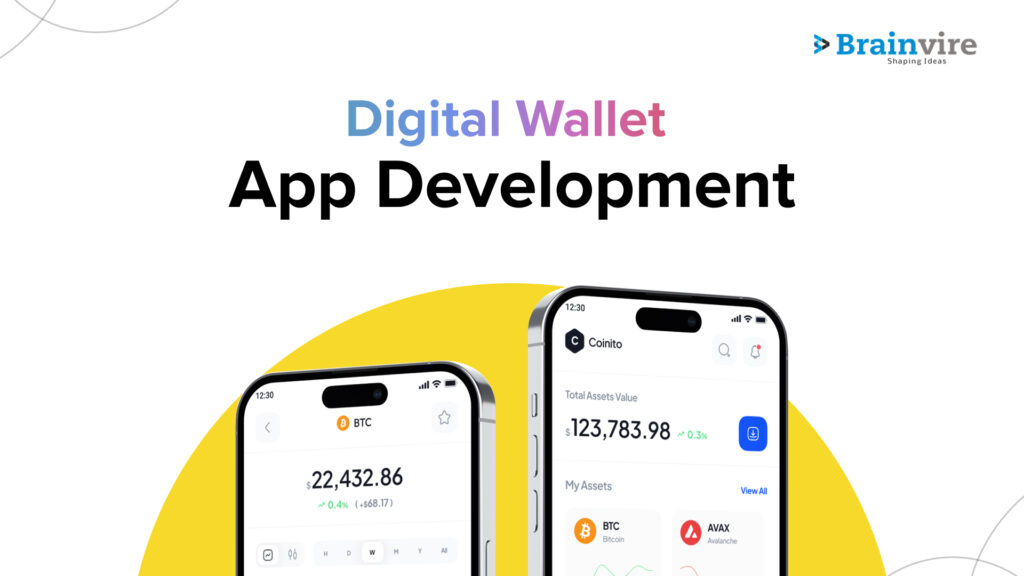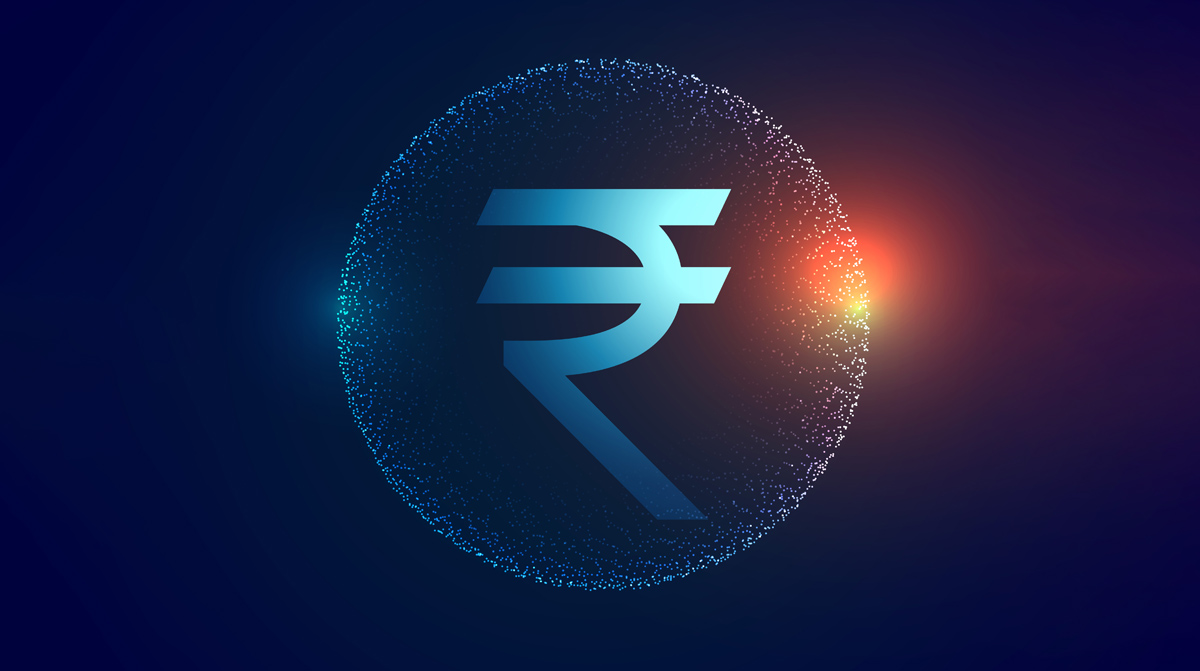Innovative digital wallet app development trends are reshaping how people conduct transactions today. As 2023 approaches, businesses increasingly hire mobile app developers to create user-friendly digital wallets that exploit emerging technologies.
Blockchain technology In digital wallets assures secure and transparent transactions, and biometric authentication in digital wallets provides an additional layer of security. Mobile integration with smart home devices is also gaining popularity, offering consumers more control and convenience.
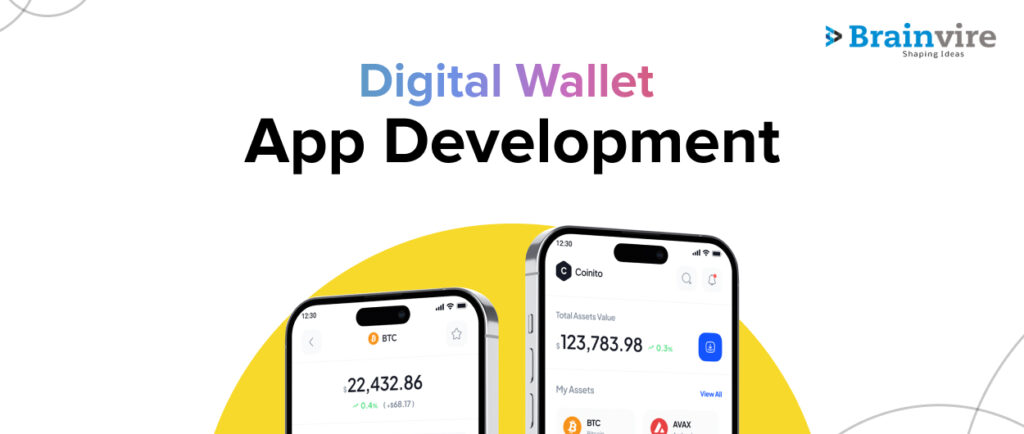
Digital Wallet App Development Trends To Focus in 2023
Trend 1: Increased Security Measures
The dangers of conducting business online have grown in tandem with the development of new technologies. In recent years, the use of digital wallets app development, particularly, has exploded in popularity due to their portability and simplicity.
This means that protecting these apps has become increasingly vital. As a result, more advanced security protocols like biometric authentication and two-factor authentication (2FA) have been used to safeguard customers’ banking data.
The Importance Of Security In Digital Wallet Apps
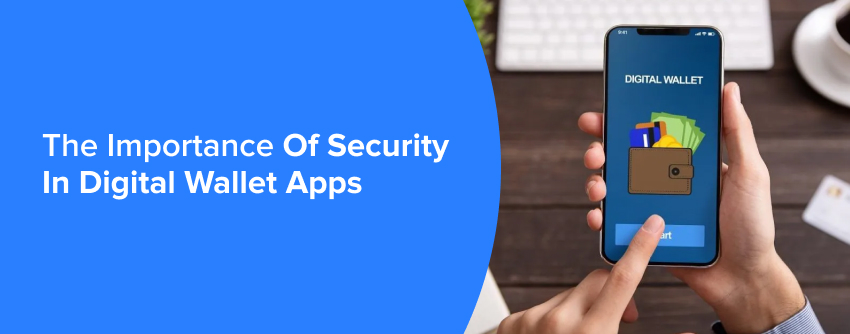
Over the past few years, digital wallets have skyrocketed because they allow users to safely and easily conduct financial transactions from their mobile devices.
These apps often save customers time by storing their credit card information so they don’t have to enter it every time they make a purchase. While convenient, these apps are also a possible target for fraudsters looking to steal users’ financial data.
Digital wallet apps development have taken several precautions to safeguard their customers from this attack. Encryption is widely used because it makes user information unreadable to anyone who doesn’t have the secret key to decrypt it. This ensures that even if a hacker gains access to the app’s servers, they cannot view any private data.
Several digital wallet apps use tokenization in addition to encryption. Tokenization is exchanging a unique token stored within an app in place of a user’s credit card data.

After receiving this token, transactions can be processed without sending sensitive credit card data over the Internet. This ensures that if a hacker intercepts a transaction, all they will get is a token that can’t be used without the matching decryption key.
Multi-factor authentication is another crucial safety feature of digital wallet apps. This entails requesting several identifiers from users before granting them access to their account or allowing them to conduct a financial transaction.
To access their digital wallet, a user may be asked for their password and a fingerprint or facial scan. There will be less opportunity for theft or fraud if only approved users have access to the app.
The Use of Biometric Authentication Methods
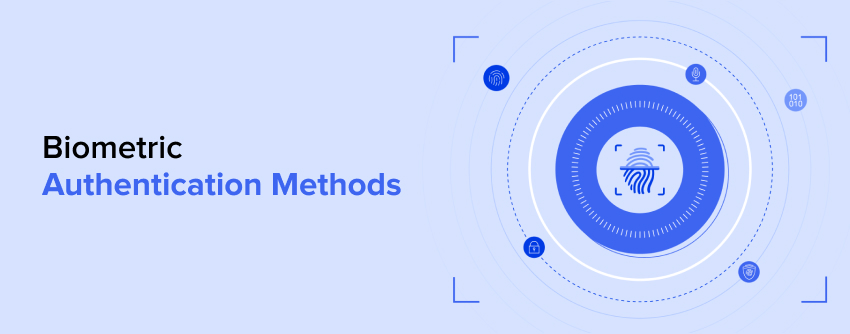
Digital wallet apps utilize biometric authentication, one of the most cutting-edge security techniques. Fingerprint readers, facial recognition systems, and iris scanners are all examples of biometric authentication methods. Due to its increased security and user-friendliness, this technology has seen rapid growth in recent years.
Biometric authentication is highly recommended to ensure that no one else may use a user’s digital wallet app without their permission. This means the app will continue to require the user’s biometric data even if a hacker obtains the user’s password or other personal information.
Now, users of many digital wallet apps development can enable an extra layer of security in the form of biometric authentication. A user may have the option of either inputting a password or using a fingerprint to unlock a digital wallet. This adds a layer of protection against cybercrime while allowing consumers to select the security methods with which they are most comfortable.
Two-Factor Authentication as an Added Layer of Security
In addition to biometric authentication, another common security solution is two-factor authentication (2FA). With two-factor authentication (2FA), users are asked to give proof of identity in two ways. This may involve a password and a one-time code given to their mobile device, a fingerprint scan, a voice recognition password, or some other combination of authentication methods.
Two-factor authentication (2FA) adds an extra layer of protection against hackers by requiring a secondary verification method before granting access to a user’s account.
A hacker who obtains a user’s password still will only be able to access their account with physical access to their mobile device or some other form of authentication. The potential for monetary loss due to fraudulent transactions can be mitigated if this is implemented.
Users of many popular digital wallet apps are requested to enable two-factor authentication (2FA) during account creation. As a result, you can rest assured that your users understand the significance of security and are taking appropriate measures to safeguard their financial data.
Trend 2: Enhanced User Experience

The field of digital wallets and online payments, in particular, has seen increased attention in recent years due to this trend. Companies are incorporating new technology and services to fulfill customers’ need for more transactional ease, speed, and convenience.
Here, we’ll delve into the growing field of improved user experience, discussing topics such as the value of a straightforward interface, the possibilities of voice-enabled digital wallets, and the role of AI and machine learning in tailoring services to individual users.
The Importance of a Smooth And User-Friendly Interface
The value of an easy-to-navigate interface cannot be overstated regarding digital wallets. To achieve this goal, the platform must be user-friendly and transparent about the steps involved in making a purchase.
Users want to be able to tailor their digital wallet’s payment settings and review past purchases. Therefore, these features must be easily accessible. Businesses might include several other features to increase their digital wallet’s usability, including mobile optimization and multi-language compatibility.
Customers are more likely to believe in a business with an intuitive UI. Companies may show their dedication to offering a high-quality service and win more loyal customers by giving them a consistent, error-free experience.
The Use of Artificial Intelligence And Machine Learning Ao Personalize The User Experience
Incorporating AI and ML to create a more tailored digital wallet experience is another important direction for the industry. Using a user’s transaction history or purchasing habits, AI and ML systems can tailor recommendations and advertising to each individual.
A digital wallet can analyze the user’s spending habits, which can then offer personalized discounts and rewards. Catering to each user’s needs can boost client engagement and loyalty.
Certain parts of the user experience, like fraud detection and customer service, can be automated using AI and ML. Businesses can save time and money by eliminating human error and introducing a more streamlined customer experience by automating these tasks.
Voice-Enabled Digital Wallets And Their Potential Benefits

Voice-enabled technology is another promising avenue for the future of digital wallets. Users of digital wallets that support speech commands can conduct financial transactions using their voice rather than their mobile device or keyboard.
There are a lot of reasons why voice-enabled digital wallets could be useful. People who are constantly on the go or have mobility issues can make everyday tasks easier and more enjoyable. Due to the need for biometric identification, such as voice recognition, voice-enabled digital wallets may also aid in lowering the incidence of fraud.
Voice-enabled digital wallets also make digital payments easier for people with mobility or sight limitations. These wallets can make digital payments more accessible to a wider audience by eliminating the need for human input.
Trend 3: Expansion of Payment Options
The world of digital payments is always expanding, with new payment choices being launched to satisfy the requirements and tastes of consumers. As a result, there has been an increasing tendency toward the growth of payment choices, notably within digital wallet apps.
Here, we will analyze this trend, concentrating on the rising number of payment alternatives accessible, the incorporation of new payment methods, such as QR codes and NFC technology, and the benefits of having several payment options within a digital wallet app.
The Increasing Number Of Payment Options Available
The past decade has seen a remarkable expansion in the number of payment methods available to consumers, particularly in the digital world. Conventional payment methods, such as credit and debit cards, are still commonly used, but several new payment choices augment them.
One of the most popular new payment alternatives is digital wallets, such as Apple Pay, Google Pay, and Samsung Pay. These apps allow users to keep their credit and debit card information and additional payment alternatives, such as prepaid cards, loyalty cards, and gift cards, in one accessible area.
Customers can then make in-store or online purchases using their mobile devices without needing a real wallet or card.
In addition to digital wallets, there has been a growth in the number of peer-to-peer payment apps, such as Venmo and Zelle. These apps allow users to send and receive money from their friends and family without cash or cheques.
They have proven particularly popular among millennials and Gen Z customers, who are more prone to utilize mobile devices for financial transactions.
Another new payment option that is gaining popularity is a cryptocurrency, such as Bitcoin and Ethereum. While still in its early stages, Bitcoin has the potential to transform the way that people make payments, giving a secure and decentralized alternative to existing payment systems.
The Integration Of New Payment Methods, Such As QR Codes And NFC Technology
As the variety of accessible payment methods has grown, digital wallet app development have integrated new payment mechanisms, such as QR codes and near-field communication (NFC).
QR codes, or quick response codes, are a type of two-dimensional barcode that a mobile device’s camera can read. Scanning a QR code at the register can use to pay for items in person.
Near-field communication (NFC) is another rapidly expanding payment option. Near-field communication (NFC) allows consumers to pay for items by tapping their smartphones on checkout terminals. Japan and South Korea are two countries where this technology has seen widespread adoption for public transportation and other payment systems.
Using QR codes and near-field communication (NFC) technologies to make purchases is simple and safe. They reduce the likelihood of loss or theft by doing away with the requirement for real cards or cash. They facilitate rapid and simple business dealings due to their speed and efficiency.
The Benefits Of Having Multiple Payment Options Within A Digital Wallet App
When a digital wallet app development supports several payment methods, it enhances the ease of use. Users can keep their billing data in one place, making it simple to utilize whenever necessary. The need to carry around multiple cards or remember various login details for different payment apps becomes unnecessary.
Having several different payment methods available is convenient and gives you more freedom. Users are free to select their preferred mode of payment regardless of the context. One common strategy is to use one card type for major purchases and another type, such as a prepaid or loyalty card, for smaller ones.
Having several different payment methods available within a single digital wallet software is a great safety feature. Users can lower their exposure to potential fraud or theft by using a distinct payment method for each transaction type. They may, for instance, prefer to use a credit card for more risky online purchases and a debit card or mobile payment app for in-store purchases.
In addition, having a variety of payment methods available within a single digital wallet software might facilitate better fiscal management. Consolidating the user’s financial dealings in one place makes them much simpler to monitor using QR or barcode.
By comprehending their spending patterns, users can be better equipped to handle their finances.
The ability of digital wallet app development to accept a larger variety of payment methods is another benefit. Users have varying tastes in making purchases, so providing multiple payment alternatives helps ensure everyone finds a way that works for them.
Finally, offering a variety of payment methods can encourage repeat business. Users will likely continue with digital wallet software rather than move to a competitor if the app supports their preferred payment methods. Customer retention and loyalty can both benefit from this.
Trend 4: Integration With Other Apps And Services
There is a trend toward combining digital wallets with other platforms as their use becomes more widespread. Thanks to this connection, users may now access their digital wallet for payments, loyalty programs, and ride-sharing services.
Here, we’ll look at the rise of digital wallets, their advantages, and several real-world applications that use this technology well.
The Trend Toward App And Service Integration
With the proliferation of digital wallets, consumers are eager to find new applications for these devices. Because of this, there has been a shift towards linking digital wallets with complementary software and services. Digital wallets can serve as a user’s one-stop shop for all of their payment and financial needs by integrating with other apps and services.
Examples of Digital Wallet Apps Integrating With Other Services
The Starbucks app effectively links with third-party services, providing an excellent illustration of digital wallet software in action. Besides paying with the Starbucks app, customers may also earn rewards and place orders in advance for in-store pickup. A key feature includes generating QR codes that link directly to a user’s rewards account, eliminating the need for physical cards. By using a built-in QR code generator, users can quickly scan and pay, collect points, and redeem rewards, enhancing both convenience and user experience.
When users connect the app to their Starbucks rewards account, they can collect points and redeem rewards without the need to carry around a plastic card. Additionally, users have the option to place their orders in advance for pickup, enabling them to skip waiting in line.
Uber is another app that has effectively merged with other services and acts as a digital wallet. Uber users can link a payment method to their accounts to pay for rides.
Users can enjoy a more streamlined payment process with this integration because they won’t have to switch between apps. Further, Uber has teamed up with organizations like American Express to provide bonuses and discounts for using their payment system.
Having a Digital Wallet That Can be Use For Multiple Purposes Offers Numerous Benefits.
Having a multifunctional digital wallet opens up a lot of possibilities. First, it makes things easier and faster for the end user. Users need not switch between apps or payment methods to make purchases or use other services. Instead, customers only need to download one app to handle their needs.
Second, an electronic wallet with various uses can be useful for better budgeting. It’s far simpler for users to keep tabs on their accounts when they can view all their transactions in a single location. Users can make better financial judgments and reduce unnecessary spending using this.
Third, working with other apps and services helps boost customer retention. If users find a digital wallet app development that provides all the required services, they are likelier to continue using that app rather than try another.
Finally, the availability of a flexible digital wallet can boost interest and adoption. Consumers are more likely to adopt a multipurpose digital wallet because of its benefits. The adoption rate and general use of digital wallets may benefit from this.
To Sum Up
Developers are enhancing digital wallets for safety, convenience, and functionality due to mobile device use and demand for contactless payments. New developments like biometric authentication, blockchain integration, and artificial intelligence will shape money management. Digital wallets will play a significant role as the sector develops.
Stay tuned: AI-Powered Banking: Enhancing Human Expertise for Improved Customer Experience
FAQs
Some of the latest innovative trends in digital wallet app development for 2023 include incorporating blockchain technology, biometric authentication. AI and machine learning, decentralized financing (DeFi), and expansion into emerging regions.
Biometric verification, two-factor authentication, encryption, tokenization, and blockchain technology are just some of the cutting-edge safety measures. Digital wallet apps will be using in 2023 to ease users’ minds about their safety. Digital wallet app providers collaborate closely with banks and government agencies to meet regulatory requirements.
Security, various payment method support, user-friendliness, seamless interaction with other banking services, real-time transaction tracking, and access to loyalty ewards programs are all must-haves for a digital wallet app in 2023.
Digital wallet apps have simplified and streamlined the payment process. Thanks to digital wallet apps, users may now conduct financial transactions without ever having to handle cash or plastic. To add to the fun, digital wallet apps allow users to keep track of all of their transactions. In real-time and grant them entry to various loyalty programs and awards.
Although digital wallet apps are on the rise, it is unlikely that they will totally replace conventional banking. While digital wallet apps streamline the payment process. Traditional banking channels remain vital for services like payday loans, mortgages, and investment management.
Yet, digital wallet apps will continue to rise, making them an increasingly important aspect of the global financial system.
The cost of developing a digital e-wallet depends on the types of features, UI, and the specific requirements. Based on your requirements, the cost of e-wallet can cost between $20,000 – $2,50,000.
Developing a digital wallet varies between different companies and the features, functionalities, and UI. While the process can take anytime between three to six months. Your e-wallet might only become functional after it passes the necessary test run.
Digital wallets are one of the most effortless and robust ways to transact money. They’re efficient and convenient medium of transacting money as customers don’t need to carry cash with them every time. Moreover, the added security features present in different digital wallets allow users to make the most of their transactions safely.
Yes, digital wallets have the possibility to impact the way we manage our finances. The safety and convenience provided by these wallets could play a significant role in allowing individuals to manage their operations.
Related Articles
-
The Most Effective Ways to Popularize Your Mobile Apps
Mobile applications, today, have become the most important need of every business in order to stay ahead of the competition. Yes, it’s the mobile apps that are quite popular among
-
5 Ways To Upsurge M-Commerce App Downloads
For retailers, selling to the customers where they spend most of the time is the way to get in the fast lane. It’s the universal truth that needs no explanation!
-
More Trending Ideas To Earn Via Mini .Net Development Projects
Talking About More Trending Ideas To Earn Via Mini .Net Development Projects, The emergence of ASP.Net has widened the gateways to develop all industry-specific projects within a shorter timeframe and

